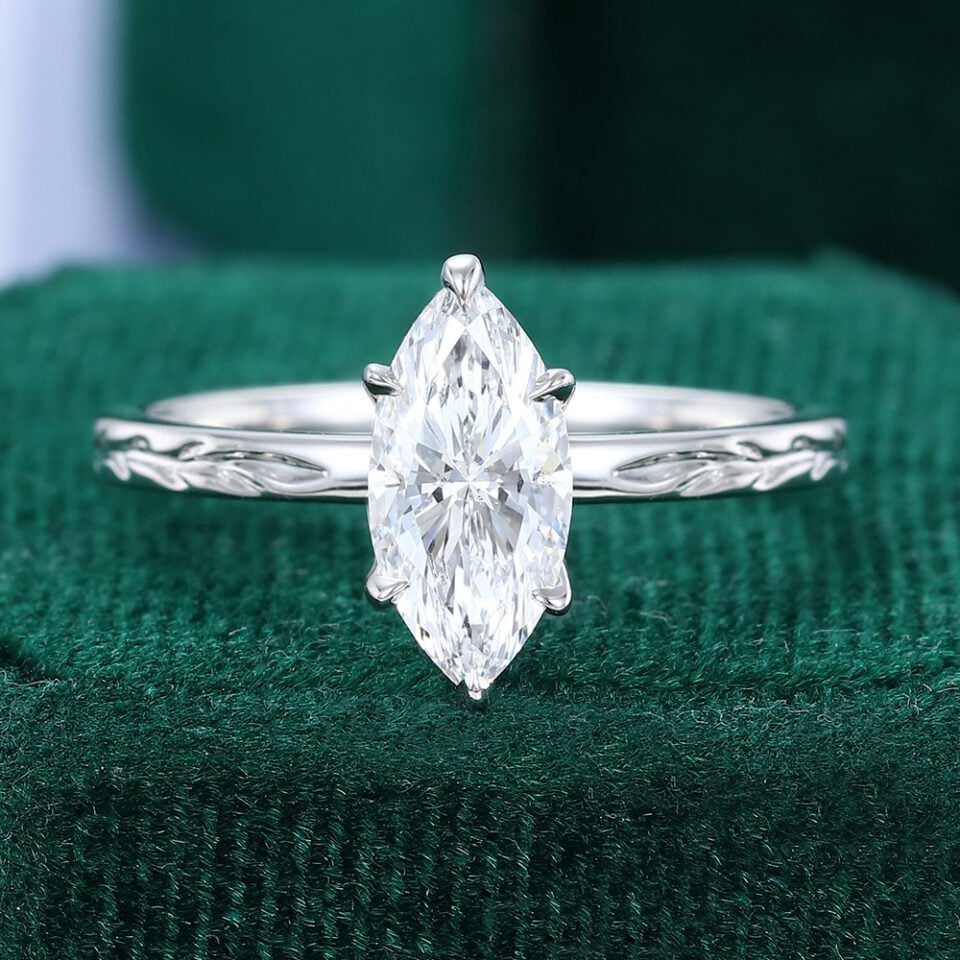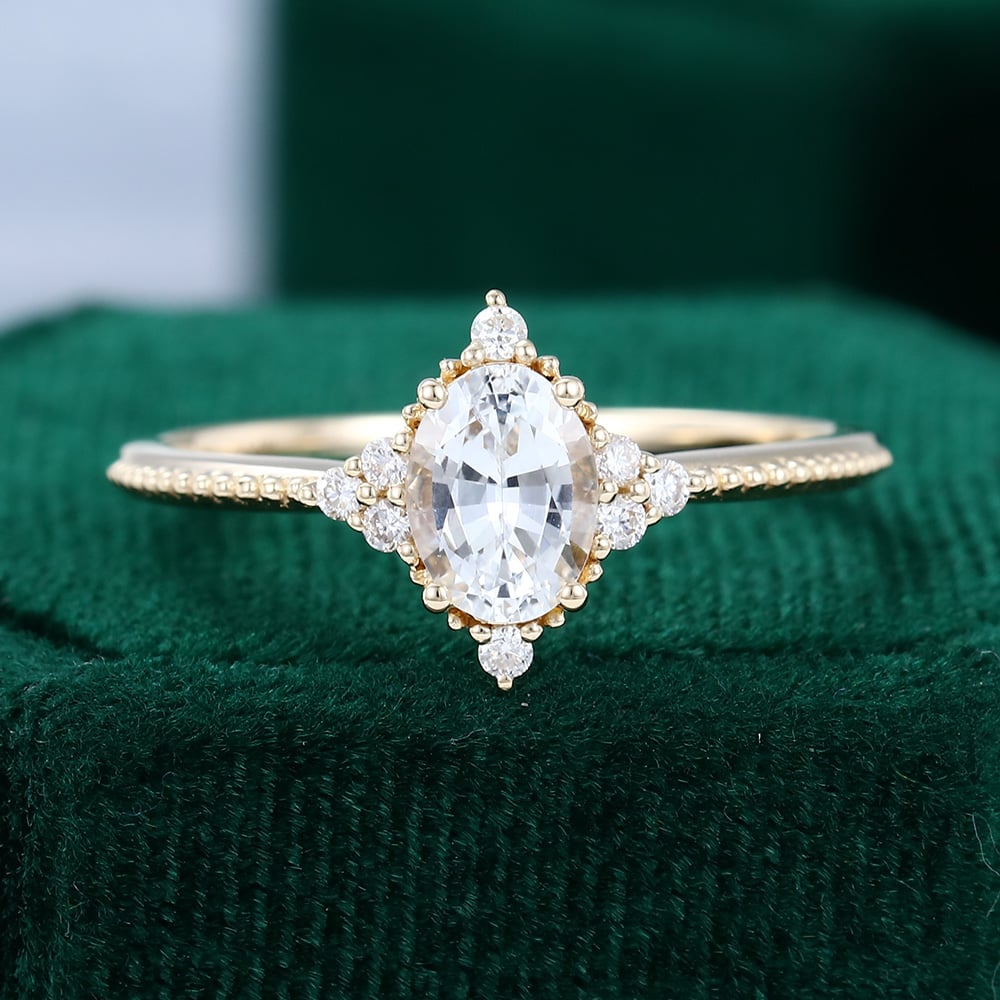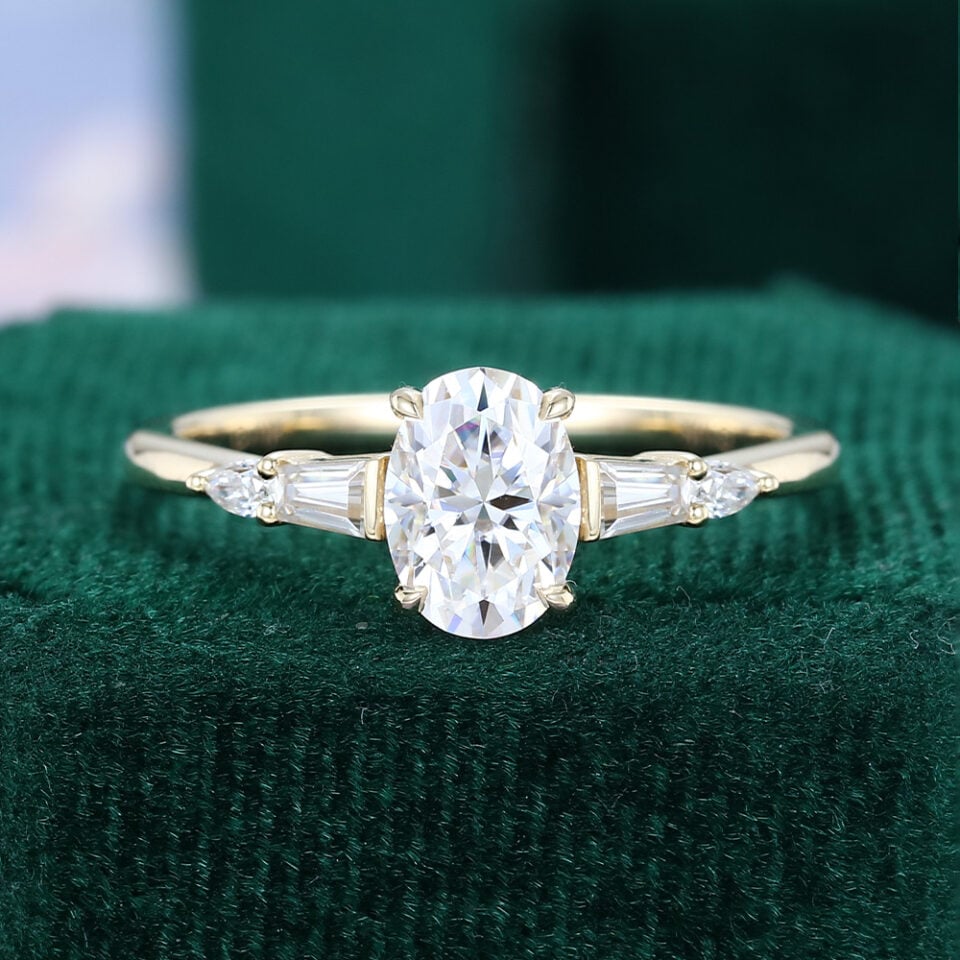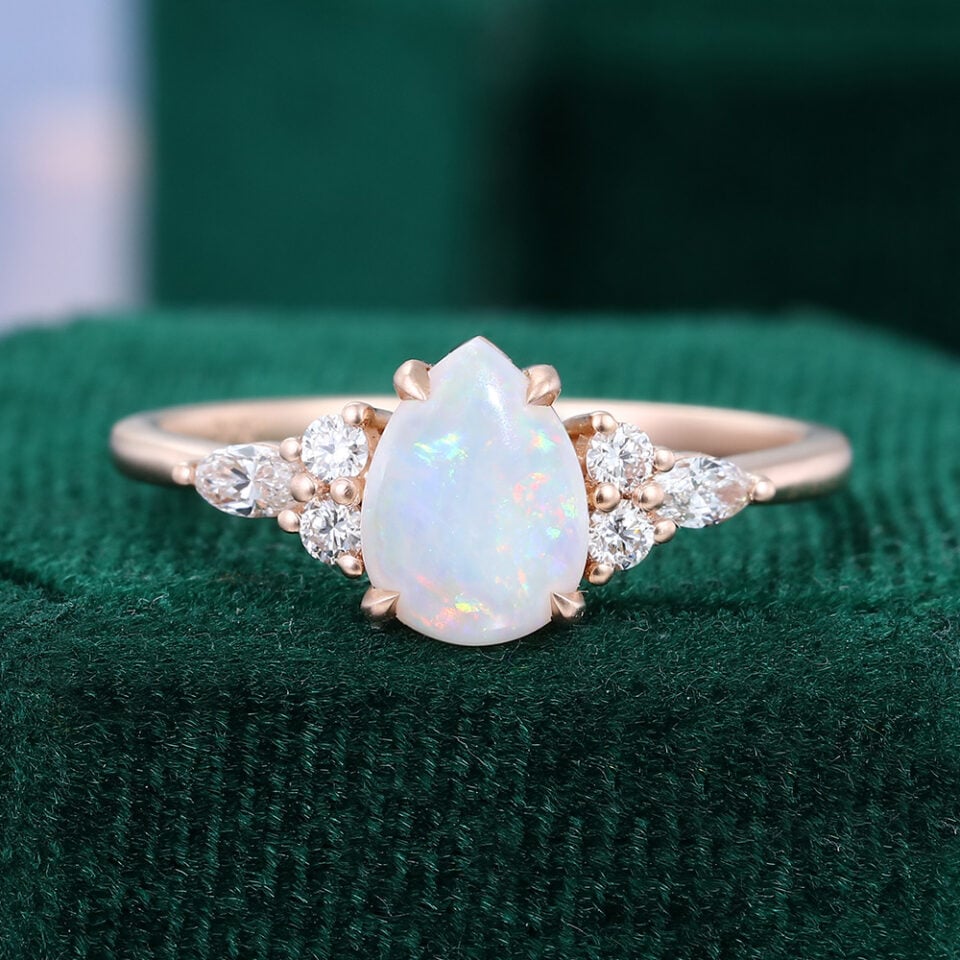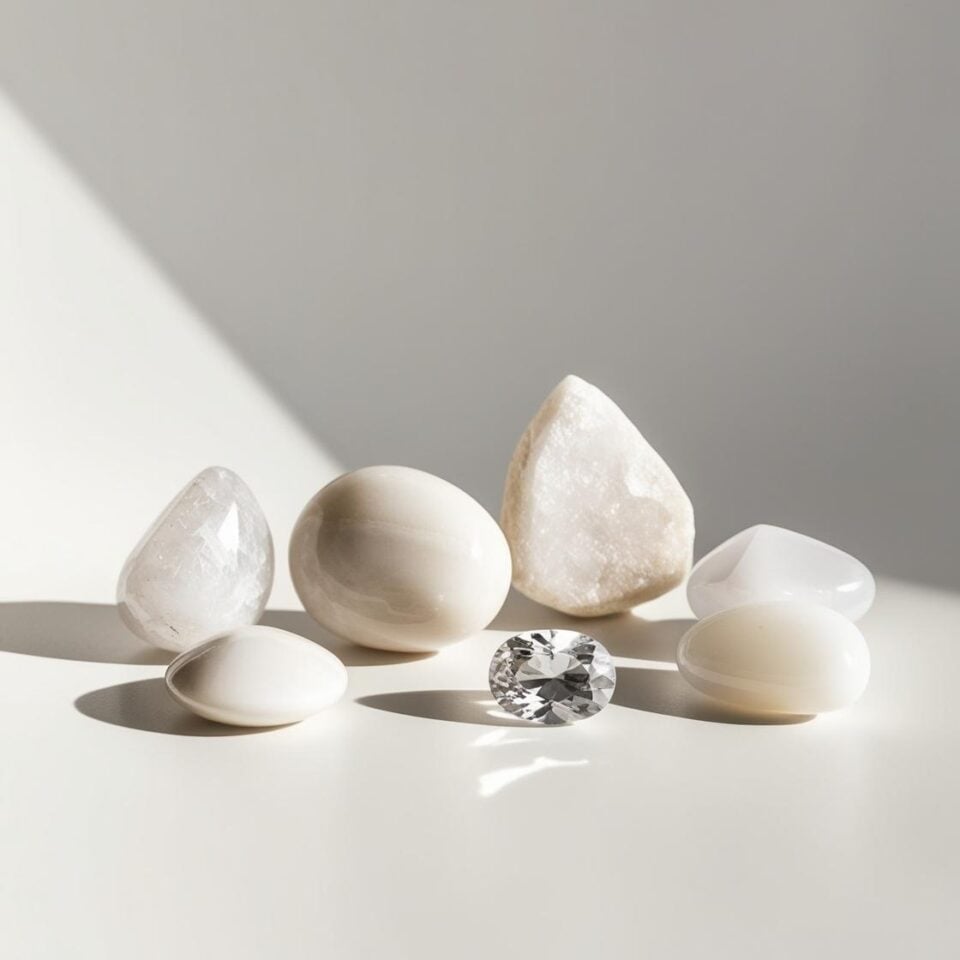
In the dazzling world of gemstones, white gemstones stand out like ethereal fairies, captivating countless hearts with their pure and elegant charm. Whether as flawless as the first snow of winter or as gentle and mysterious as moonlight, they embody humanity’s longing for beauty, purity, and eternity. In this article, we’ll explore the white gemstones commonly seen in the jewelry market and take you through the unique appeal of each one. Ready? Let’s dive in…
To make this article easier to read, we’ve divided it into two main sections:
There are only four types of precious gemstones: diamond, ruby, sapphire, and emerald. All other gemstones fall into the category of semi-precious stones. (You can click to jump to the section you’re most interested in.)
White Precious Gemstones
Among the four precious gemstones, two have white varieties:
Diamond
This is the finest white (colorless) gemstone! As the most traditional and commonly known type of diamond, the white (colorless) diamond needs no introduction. It has the highest hardness level in nature (Mohs hardness of 10), boasts exceptional brilliance, and symbolizes eternal love, making it the top choice for engagement rings. Additionally, the diamond is the birthstone for April and is also associated with 10th and 60th anniversaries.
While natural diamonds are undeniably beautiful, many people remain cautious about them. On one hand, there’s a desire to own their beauty; on the other hand, there’s concern about unethical mining practices and conflict-related issues. However, tracing the origin of a natural diamond is extremely difficult. Fortunately, with technological advancements, diamonds can now be created in laboratories. Lab-grown diamonds are increasingly accepted by consumers – they are physically and chemically identical to natural ones, but typically cost only one-tenth as much. (Yes, really – they are exactly the same in every way except for how they are formed.)
White Sapphire
White sapphires – sounds surprising, right? But they’re very real!
Corundum is classified into two precious gemstones: ruby and sapphire. All colors of corundum except red (ruby) are considered sapphires. The white color of white sapphires comes from trace elements like iron and titanium arranged in a specific way that doesn’t absorb visible light, resulting in a soft white or colorless appearance. These stones feature a silky luster and gentle fire. While they’re not as dazzling as diamonds, they have a cooler, more serene look. With a high hardness level (Mohs 9), they are highly resistant to wear, making them ideal for everyday jewelry. Thanks to their diamond-like appearance and more affordable price, white sapphires are a popular diamond alternative. Also, sapphire is the birthstone for September. Fortunately, sapphires come in a wide range of colors, giving September-born individuals plenty of beautiful options to choose from.
White Semi-Precious Gemstones
Semi-precious gemstones include all gems that are not classified as precious stones. While the exact number is unknown, there are many white semi-precious gemstones. Below are 18 popular white semi-precious stones commonly used in jewelry:
- White Pearl
- Moissanite
- White Topaz
- White Zircon
- White Opal
- White Moonstone
- White Labradorite (White Rainbow Moonstone)
- White Quartz (Rock crystal & Milky Quartz)
- White Garnet (White Grossular & White Hydrogrossular)
- White Tourmaline
- White Agate
- White Nephrite / Jadeite
- Goshenite
- Danburite
- Colorless Spinel
- White Zoisite
- White Calcite
- White Sodalite
White Pearl
This white gemstone is not a mineral – it’s an organic gem formed by mollusks such as oysters. White pearls have a soft, warm luster that is uniquely pearlescent. They are timeless classics, symbolizing purity, wisdom, and feminine charm. White pearls are also one of the birthstones for June and the traditional gift for 3rd wedding anniversaries. Unlike most gemstones, pearls do not require cutting or polishing. They naturally occur in various shapes, including round, oval, and baroque. Pearls are widely used in necklaces and earrings, and they’re also known for certain medicinal and cosmetic benefits.
Moissanite
With a Mohs hardness of 9.25, second only to diamonds, moissanite is one of the most popular diamond alternatives in recent years, thanks to its brilliance (its refractive index and dispersion are even higher than a diamond’s). Its chemical composition is silicon carbide, and it is extremely rare in nature. Most moissanite on the market is lab-grown. (Why are 99% of moissanite lab-created? Because this gem was first discovered in meteorite debris and is often referred to as a gemstone from space.) Like traditional white diamonds, moissanite is usually colorless to light yellow, combining beauty with affordability. Thanks to modern technology, lab-grown moissanite can now also be produced in various colors such as gray and green.
White Topaz
Colorless or white is the most common shade of topaz, although trace elements can give rise to other colors such as brown or yellow. White topaz has a clean appearance and usually high transparency, with a bright glassy luster. (When free of impurities, it appears colorless.) It has a Mohs hardness of 8, making it durable and suitable for cutting into many shapes. White topaz is often used in necklaces, bracelets, and other jewelry, with its pure white color adding a touch of elegance. This variety is also commonly heat-treated or irradiated to produce the vivid blue topaz that’s currently very popular. White topaz is also considered one of the birthstones for November. Although yellow topaz is traditionally associated with the month, the official birthstone list refers to “topaz” in general, without specifying a single color.
White Zircon
Zircon has a high refractive index, and a well-cut white zircon can display a brilliant sparkle, closely resembling that of a diamond. In the past, some dishonest sellers even passed off white zircon as diamonds. This white semi-precious gem is usually colorless to white (ranging from transparent to semi-transparent). With a Mohs hardness of 7.5, it’s suitable for everyday wear, though it is relatively brittle and should be handled with care to avoid chipping. Natural zircon can contain radioactive elements, but most zircon used in jewelry today has been treated to enhance safety and appearance. Zircon is also one of the birthstones for December.
White Opal
White is the most common color of opal, which makes it more affordable compared to other color varieties. This white semi-precious gemstone isn’t pure white throughout – it features a white or milky base color with a unique play-of-color effect on the surface. This means it flashes rainbow-like colors at different angles and under various lighting. The play-of-color comes from the diffraction and interference of light caused by the orderly arrangement of nanometer-sized silica spheres inside the stone.
Unlike most gemstones, white opal is rarely faceted in brilliant cuts or step cuts. Instead, it is often cut into cabochon shapes to best showcase its mesmerizing color play. Opal is relatively soft (Mohs hardness of 5.5–6) and typically contains a high water content (3–21%). To maintain its beauty, it should not be stored in overly dry environments for long periods and may benefit from occasional moisturizing care. Oh yeah! Opal is also one of the birthstones of October.
White Moonstone
Moonstone is part of the orthoclase (feldspar) family and is named for the soft white or bluish glow it displays, which resembles moonlight. This optical phenomenon is called adularescence. White moonstone is usually semi-transparent to transparent, ranging from colorless to white, with a delicate texture and a Mohs hardness of 6.
In ancient times, moonstone was considered a symbol of love and mystical power, often used in romantic-style jewelry. Some cultures even believe wearing moonstone can grant moonlight magic. Moonstone is also one of the birthstones for June.
White Labradorite (White Rainbow Moonstone)
White Labradorite (also known as White Rainbow Moonstone) is often mistaken for a type of moonstone, but it actually belongs to a different mineral group. While moonstone is part of the orthoclase (feldspar) family, white labradorite comes from the plagioclase feldspar family. (See Moonstone vs. Rainbow Moonstone to learn more.)
White Labradorite has a milky white to semi-transparent base and displays flashes of blue, green, or gold when viewed under light. This mystical optical effect is known as labradorescence. With a Mohs hardness of about 6 to 6.5, it’s suitable for pendants, rings, and other jewelry pieces. White labradorite is believed to symbolize intuition, spiritual awakening, and inner clarity, making it a favorite among lovers of metaphysical and spiritual jewelry.
White Quartz (Rock Crystal & Milky Quartz)
There are two common types of white quartz in the quartz family – rock crystal and milky quartz. Both have a Mohs hardness of 7, are abundantly available, and are affordable. They are also popular in the field of crystal healing, symbolizing purity, balance, and calmness.
- Rock crystal, also known as pure quartz, clear quartz, or white crystal, is a pure form of silicon dioxide and typically appears colorless and transparent to semi-transparent.
- Milky quartz gets its milk-like, white appearance from microscopic gas-liquid inclusions or fine crystal particles inside the stone. It is opaque or semi-transparent. While not as clear as rock crystal, it exudes a gentle and peaceful vibe.
White Garnet (White Grossular & White Hydrogrossular)
Garnet is the birthstone for January, but few people know that this gemstone comes in a wide range of colors, not just red. White garnet is a rare and special variety in the garnet family, including white versions of grossular and hydrogrossular garnet. (Hydrogrossular is a jade-like variant of grossular garnet.)
White garnets have a good luster and high refractive index, giving them an elegant, cool glow under light. Although not as common as red garnets, their unique white hue adds a sense of rarity and mystery.
- White grossular garnet is transparent to semi-transparent, usually colorless to white, with a Mohs hardness of 6.5–7.
- White hydrogrossular garnet is semi-transparent to opaque, mostly white (sometimes colorless), with a Mohs hardness ranging from 7 to 7.5.
White Tourmaline
Tourmaline is known for its wide range of colors, but white tourmaline is relatively rare. Its pale appearance is due to an extremely low or absent concentration of color-causing elements in its chemical composition. White tourmaline typically ranges from colorless to milky white, with good transparency and luster. With a Mohs hardness of 7 to 7.5, it’s both beautiful and durable. Compared to more vibrant tourmaline colors, white tourmaline feels more refreshing and ethereal, often giving off a spiritual vibe. Tourmaline is one of the birthstones of October.
White Agate
Agate is a variety of cryptocrystalline quartz. White agate has a pure color and fine texture, often featuring natural patterns or banded structures. With a Mohs hardness of 6.5 to 7, it is fairly tough and well-suited for carving and polishing. White agate can be pure white or show shades of gray, yellow, or cream, such as milky agate or white-banded agate. Some white agates may have distinctive white or pale gray patterns, like blue-banded agate. Others may feature a white base with colorful inclusions, such as moss agate. There are also extremely rare types of colorless agate that appear nearly transparent.
White Jade (White Nephrite / Jadeite)
White jade comes in two types – nephrite (composed mainly of tremolite-actinolite) and jadeite (a sodium aluminum silicate). In East Asian cultures, white jade holds deep symbolic meaning, representing purity, goodness, and good fortune. It has a smooth, delicate texture and appears translucent to semi-translucent, often in ivory or milky white tones. Although it doesn’t sparkle like some gems, its soft and refined appearance gives it a noble and pure aesthetic. Hardness varies by type: nephrite has a Mohs hardness of around 6–6.5, while jadeite ranges from 6.5–7. White jade often isn’t a perfectly pure white—it may include other subtle hues, adding to its unique elegance.
White Beryl (Goshenite)
A member of the beryl family, white beryl – also known as goshenite or lucid beryl – has little to no trace elements that cause color, making it appear colorless or white. It boasts excellent clarity and a glassy luster, with a Mohs hardness of 7.5–8. Elegant yet understated, it’s a refined choice for a white gemstone. Known as the “mother of all gemstones,” goshenite can be treated to create more well-known beryl varieties like emerald, aquamarine, and morganite.
Danburite
Danburite usually appears colorless to white, though it can also be gray or pale brown. It features a high refractive index and excellent clarity, giving it a soft brilliance. With a Mohs hardness between 7 and 7.5, danburite crystals are often prismatic in shape. In the realm of spiritual and wellness culture, danburite is believed to help release stress and promote emotional healing. It has been gaining popularity in the high-end spiritual gemstone market in recent years.
Colorless Spinel
Colorless spinel is a relatively rare variety within the spinel family, with natural specimens being particularly scarce. It has a brilliant luster and high transparency, visually resembling white diamonds but at a more accessible price point. With a Mohs hardness of 8, it is not only visually appealing but also durable, making it an excellent choice for daily-wear rings or as a center stone. Spinel is also one of the birthstones for August.
White Zoisite
White zoisite is a lesser-known variant of the zoisite family. It typically appears milky white or semi-translucent, sometimes with hints of gray or pale yellow. Compared to more vivid varieties like green zoisite or the chromiferous purple-blue tanzanite, the white version feels more serene and understated, exuding a quiet, natural elegance. White zoisite is favored in handmade jewelry, energy stones, and spiritual pieces for its association with clarity of thought and emotional balance. With a Mohs hardness of around 6–7, it offers decent durability but should still be worn with care.
White Calcite
White calcite displays a soft milky or semi-translucent appearance, often with natural veining. As a calcium carbonate mineral, it has a relatively low refractive index and exhibits a waxy to vitreous luster. Although it’s not very hard (Mohs hardness ~3), its organic look and affordability make it popular in crystal healing and decorative jewelry. It adds a serene and natural vibe to any design.
White Sodalite
Though typically recognized for its deep blue color with white veining, sodalite also exists in pale or even pure white forms. White sodalite is especially artistic in appearance, often featuring cloudy or snowflake-like patterns. With a Mohs hardness of 5.5–6, it’s best suited for pendants, earrings, and decorative pieces. It adds a unique visual flair, blending natural patterning with a soft, snowy aesthetic.
Final Thoughts
In this article, we’ve covered 20 white gemstones – 2 precious and 18 semi-precious. Each one shines in its own unique way. Which one caught your eye?
At MollyJewelryUS, we offer a wide variety of gemstone jewelry. Explore our shop to find that perfect white gemstone you’ve been looking for!
FAQs About White Gemstones
What do white gemstones symbolize?
White gemstones often symbolize purity, elegance, and timelessness.
What is the most popular white gemstone?
Diamonds are the most popular white gemstone.
Which white gemstones are suitable for everyday wear?
Any gemstone with a Mohs hardness above 7.5 is great for daily wear, like diamonds, white sapphires, moissanite, white topaz, and colorless spinel. Softer stones can also be worn daily with protective settings like bezels.
Which white gemstone is best for an engagement ring?
The best white gemstone for an engagement ring comes down to your personal preference. Diamonds are the classic choice, but if you’re looking for something more budget-friendly, moissanite, white beryl, or white topaz are beautiful alternatives.
What are the most common white gemstones?
Common white gemstones include diamonds, pearls, zircon, white jade, white opal, white moonstone, white topaz, and white quartz.
Which birthstones are white?
White birthstones include:
- January: White garnet
- April: Diamond
- June: Pearl, Moonstone
- August: Colorless spinel
- September: White sapphire
- October: White tourmaline, White opal
- November: White topaz
- December: White zircon
Which white gemstone is the hardest?
Diamonds – ranking at a 10 on the Mohs hardness scale – are the hardest gemstone of all.
